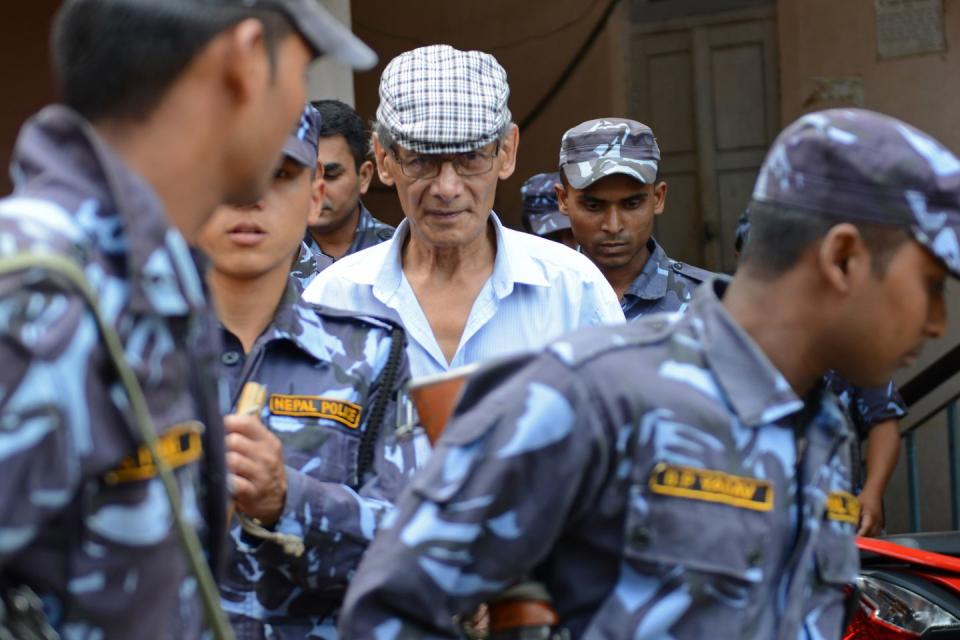The True Story of 'The Serpent' Serial Killer Charles Sobhraj

In Netflix’s BBC pick-up, The Serpent, Tahar Rahim brings to cinematic life once again the story of Charles Sobhraj (alias for much of the series: “Alain Gautier”), the so-called “Bikini Killer,” who preyed on tourists traveling through southeast Asia’s “Hippie Trail” during the 1970s.
The celebrity of Sobhraj has persisted for some time. After his release from jail in India in 1997, Sobhraj reportedly sold the rights to his exploits to a French producer for $15 million. His story is one of deception and mass murder. Between 1972 and 1976, Sobhraj is believed to be responsible for between 12 and 24 killings. The victims were all Western travelers visiting Thailand and the Indian subcontinent.
The BBC/Netflix series likely takes inspiration from the many accounts of Sobhraj’s killings, including Thomas Thompson’s Serpentine, which chronicles not just Sobhraj, partner Marle‐Andrée Leclerc, and apparent henchman Ajay Chowdhury's crimes, but also the harrowing investigation by Dutch diplomat Herman Knippenberg, who is, by all accounts, the hero of the story.
While The Serpent fictionalizes some aspects of the history—mainly the dialogue, which, the series points out, is entirely made up—the underlying tale and its players are all very real. Knippenberg has even said in a recent interview that, at times, the series felt "dangerously close" to the real thing.
Here’s the true story behind The Serpent.
Who is Charles Sobhraj?
Sobhraj was born in Japanese-occupied Saigon in 1944. As a child, Sobhraj was reportedly a chronic bed wetter, liar, and thief. In 1962, he was arrested in Paris for stealing a car. After another robbery charge, he served a three-year jail sentence soon after. In prison, he learned karate and Italian. Sobhraj later married and, in 1970, moved with his wife and infant daughter to Greece, then to Hong Kong, then to Macao, where he abandoned them.
He later met Marle‐Andrée Leclerc who became his mistress and partner. By this time, in the early '70s, he had begun drugging, robbing, and reportedly killing travelers. The drugs would cause dysentery and incapacitate them. Sobhraj was eventually arrested in India in 1971, but he escaped jail by faking an appendicitis. In 1975, Sobhraj was operating as a gem dealer in Bangkok. Sobhraj would later say, “As long as I can talk to people, I can manipulate them.”
One French woman, however, did go to the British Embassy with the story. She was turned away. During this time, Dutch diplomat Herman Knippenberg began independently investigating the death of two Dutch citizens, despite pressure from his superiors to stop.
“It was all so easy for [Sobhraj],” Knippenberg would say later. “The murders, the deception, everything. He had got away with so much for so long that he believed he was invincible. Personally, I think he might have killed many more. Inside his Bangkok apartment, we found a stack of passports and driver's permits. They could have easily belonged to others.”
Knippenberg’s investigation led to Sobhraj and Leclerc’s arrest by Thai police. The couple, however, later escaped.

Their freedom was short lived. In New Delhi, they were set upon by a French tour group after the couple had tried to drug them. The Indian government found Sobhraj guilty of only one murder, and he was given a seven-year prison sentence. He escaped several years later by drugging prison guards, but was later arrested. Some speculate the escape was designed to add to his prison sentence and, therefore, avoid extradition to Thailand where he could be executed for his crimes.
Leclerc had denied any knowledge of Sobhraj’s murders. (It is believed that she did help Sobhraj drug at least one of his victims.) One victim later claimed that Leclerc “had to know about it. Anyone with eyes and ears could see what was going on in this apartment.” However, the same Indian court that sentenced Sobhraj overturned Leclerc’s conviction. She had been diagnosed with cancer and was allowed her to return to Canada. She died there in 1984.
By the time Sobhraj left Indian prison in 1997, the time frame needed for him to be tried in Thailand had lapsed. He was free. He immediately moved to Paris, embracing his public infamy.

Where is Charles Sobhraj now?
In 2003, Sobhraj was arrested in Kathmandu for murder and traveling with a false passport. The murders—American backpacker Connie Jo Boronzich and Canadian tourist Laurent Carrière—had occurred in 1975. He was given a life sentence.
As in the Netflix series, it was Knippenberg's documentation that would help convict Sobhraj. “He wanted to move from the shadows into the limelight by showing up in the one place where he knew he had committed murders but they would not have the evidence anymore,” Knippenberg told the Daily Mail in an interview. “But he forgot I still had the documents. He was a gambler. It was like he always did with casinos, putting everything on black. But then it landed on red.”
With Sobhraj's arrest, Knippenberg's nearly 30-year pursuit of the man had finally, it appeared, come to an end. “It took a long time to get Sobhraj, many years,” he said. “But I had to do it. He got inside me like some sort of tropical malaria. He wouldn't go away. This is not over until Sobhraj and I are in different worlds. If there is a Hell, I am sure he is a candidate.”
Sobhraj is still currently serving out his life sentence in Nepal. He is 76 and has reportedly received several heart surgeries while in prison.
You Might Also Like

